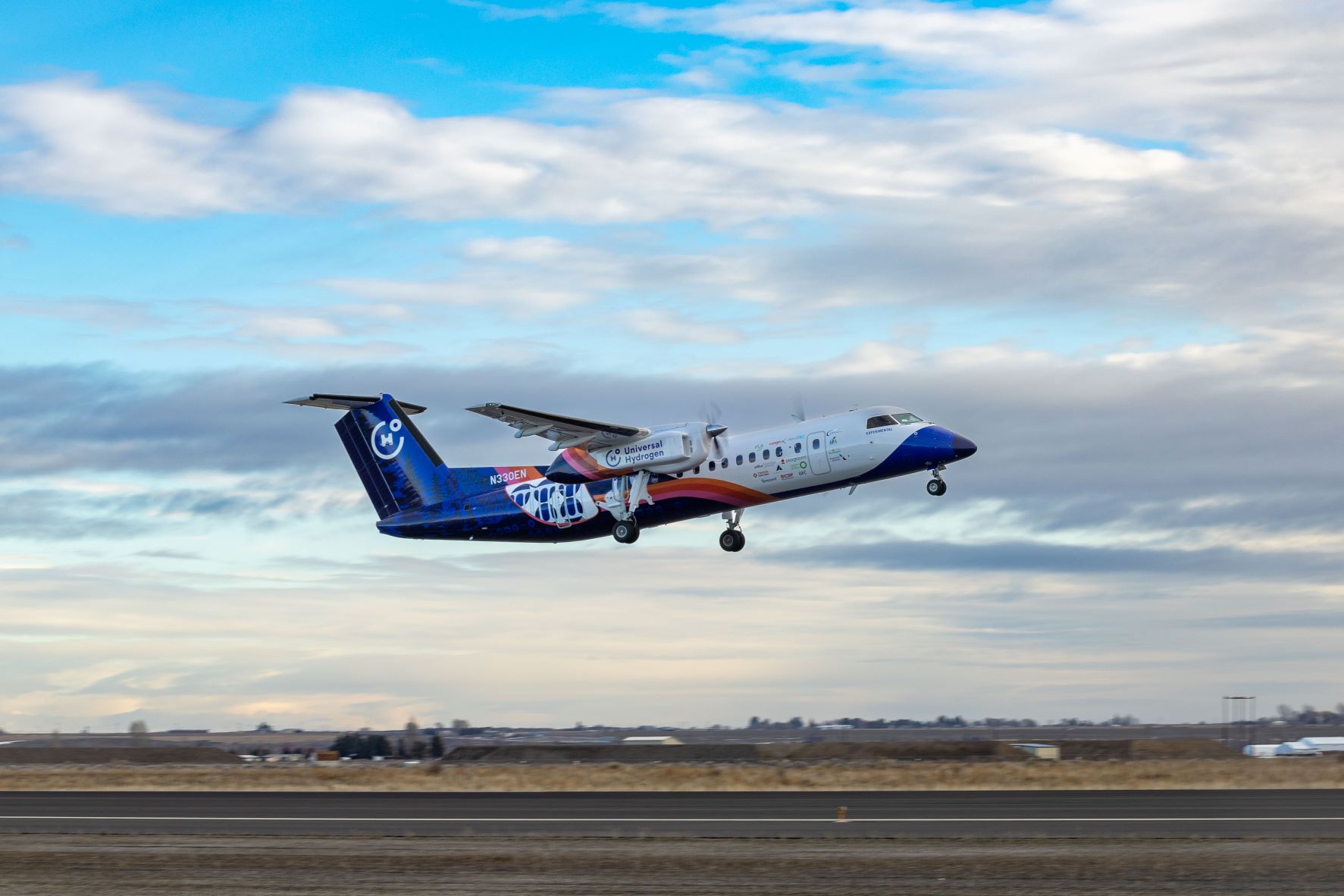
First flight of hydrogen regional airliner
Submitted by:
Sara Waddington
Universal Hydrogen Co. flew a 40-passenger regional airliner using hydrogen fuel cell propulsion on 3 March 2023. The aeroplane, nicknamed Lightning McClean, took off at 8:41am PST from Grant County International Airport (KMWH), USA, and flew for 15 minutes, reaching an altitude of 3,500 MSL.
The flight, conducted under an FAA Special Airworthiness Certificate, was the first in a two-year flight test campaign expected to culminate in 2025 with entry into passenger service of ATR 72 regional aircraft converted to run on hydrogen. Representatives from Connect Airlines and Amelia, the U.S. and European launch customers for the hydrogen airplanes, respectively, were on hand to witness the historic flight.
“The flight is the largest hydrogen fuel cell-powered aeroplane ever to take to the skies and largest airplane to cruise principally on hydrogen. We have a rapidly growing order book, today totalling 247 aircraft conversions from 16 customers worldwide, with over US$ 1 billion in conversions backlog and over US$ 2 billion in fuel services over the first ten years of operation,” commented Universal Hydrogen Co.
“Today will go down in the history books as the true start to the decarbonisation of the global airline industry and we at Connect Airlines are extremely proud of the role that we, as the first U.S. operator, will play in leading the way with Universal Hydrogen,” said John Thomas, CEO of Connect Airlines. Connect, which will begin a regional turboprop service this spring, has placed a first-position U.S. order with Universal Hydrogen to convert 75 ATR 72-600 regional aeroplanes to hydrogen powertrains with purchase rights for 25 additional aircraft conversions. Deliveries will start in 2025.
“We have committed to being North America’s first zero-emission airline and this historic flight, taking hydrogen, which can be made with nothing but sunshine and emitting only water, is a key milestone on our journey,” continued Thomas.
In this first test flight, one of the aeroplane’s turbine engines was replaced with Universal Hydrogen’s fuel cell-electric, megawatt-class powertrain. The other remained a conventional engine for safety of flight.
The company’s powertrain is built around Plug Power’s ProGen family of fuel cells specially modified for aviation use. The powertrain does not use a battery—the fuel cells drive the electric motor directly—drastically reducing weight and cost. The motor, a modified magni650 electric propulsion unit, and power electronics were supplied by Everett-based magniX. Seattle-based AeroTEC assisted with engineering efforts, including design of the modified nacelle structure, aircraft systems design and integration, as well as aircraft modifications and installation of the Universal Hydrogen powertrain onto the flight test aircraft, accomplished in less than 12 months.
The test flight comes on the back of successful demonstrations in December 2022 of Universal Hydrogen’s modular hydrogen logistics system conducted at the company’s engineering centre in Toulouse, France.
“Our business model resolves the chicken-and-egg problem between hydrogen aeroplanes and hydrogen infrastructure by developing both in parallel and with a uniquely low-cost approach,” said Paul Eremenko, co-Founder and CEO of Universal Hydrogen. “The aeroplanes are converted to hydrogen using an aftermarket retrofit conversion kit, tackling the existing fleet rather than developing a new aeroplane. And hydrogen fuelling uses modular capsules compatible with existing freight networks and airport cargo handling equipment, making every airport in the world hydrogen-ready.”
The company, backed by GE Aviation, Airbus Ventures, Toyota Ventures, JetBlue Ventures, and American Airlines, as well as several of the world’s largest green hydrogen producers and financial investors, plans to springboard from regional airplanes to larger ones and to hydrogen fuel deliveries for other mobility applications using its modular logistics network.
“More than half of aviation CO2 emissions today come from the A320 and 737 family of aircraft,” said Eremenko. “Both Airbus and Boeing will need to replace these venerable aeroplanes with a new design starting development in the late-2020s and entering passenger service in the mid-2030s. Making their successors hydrogen airplanes is a golden opportunity—perhaps the only opportunity—for aviation to get anywhere near meeting Paris Agreement emissions targets without having to curb aviation traffic volumes.”
